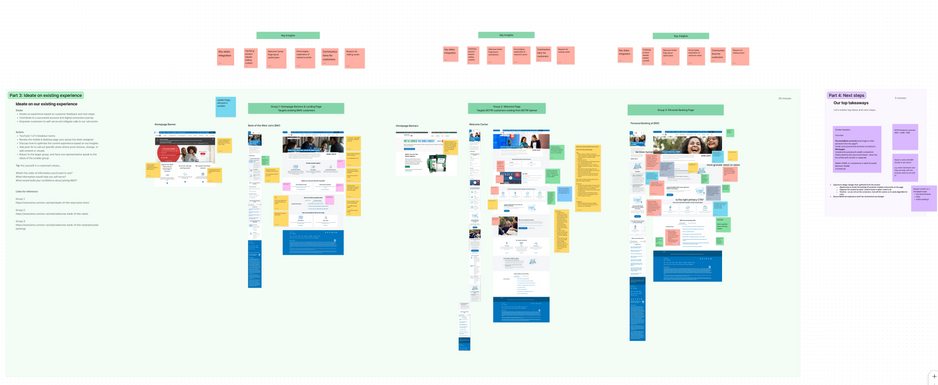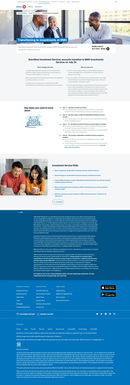Bank of the West Transition Center
Client
BMO (Bank of Montreal)
Role
Content Designer
Team
Immediate:
Semire Bamikole - PD
Suzie Menendez - DPM
Reena Hanson - DPO
Stakeholders:
Marketing
Brand
C- Suite Strategic Partners
Legal Regulatory Compliance
Developers
QA
Type
Mini Website (19 pages)
Duration
1 year (October 2022 - September 2023)
Tools Used
-
Microsoft Excel
-
Microsoft Word
-
Adobe Analytics
-
Figma
-
FigJam
Results
A 19-page website across 4 lines of businesses that includes information about the acquisition, key updates about the transition and ensured a smooth transition of over 2+ million Bank of the West customers to BMO across the U.S.
And recently was named the 2024 Celent Model Bank Winner for Integration Excellence.

Backstory
I was approached by the Director of Marketing and the Director of Experience Design to work on a transition/welcome center for Bank of the West customers who were going to be transitioning to BMO accounts by Labour Day Weekend 2023. I was later introduced to the (many) stakeholders involved and my design partner and I went over a our plan of approach. When we spoke with our Digital Product Manager we created a work back schedule to ensure that we would be targeting all of our key dates on time.
The Problem
BMO had recently acquired Bank of the West in December 2022 and was looking to transfer over 2 million Bank of the West customers to BMO.
Bank of the West was previously acquired by BNP Paribas for several decades.
Customers at Bank of the West felt uneasy because of three big reasons:
1. Many were not aware of BMO or the acquisition taking place.
2. They were also unaware of who BMO was and its growing impact across the United States of America.
3. They were previously acquired by BNP Paribas a few decades prior and are worried about going through a massive change once again.
We needed to gain the trust of incoming and transitioning users from Bank of the West as well as, help deliver important pieces of information within a tight timeline to have a smooth transition.
The Proposed Solution
This transition would consist of cross-functional communication and partnership with the marketing, brand, legal and product (functional QA and development teams). We launched 19 pages across 4 LOBs with timely updates to cover all the different phases during the transition.
The Approach
This project was split into three phases. Phase 1 consisted of pre-transition content such as getting to know BMO, as well as preparing Bank of The West customers with the proper information to make informed decisions before and during their transition.
Phase 2 consisted of specific content for each LOB indicating important pieces of information such as key dates in a timeline format, materials needed for the transition, important callouts such as major changes to their accounts or outages, as well as a space to get to know their new bank and who to contact in case there are any questions.
The final phase (Phase 3) had a few post-transition updates such as an introduction to BMO's products (based on the specific LOB), and key dates for smaller transitions for more niche clientele.
The Personas
Our first exercise as a team was to discover the pain points of our Bank of the West users, knowing some of the information already, we created high level personas speaking to the user goal, needs, frustrations and the actions users may take while exploring the transition center. These personas are based on the survey results we were receiving from the site (more on this below).
The Research— Gathering Insights
First my design partner and I conducted a small competitive analysis of two other banks that had recently gone through an acquisition/merger.
A few things looked at were the information architecture and the journeys users took to get from the main page to the page with the acquisition information.
A few things we noticed were:
- How they've laid out their content, putting the important facts in the first third of the page was important for users who just needed quick updates. Using different headings were also important to create hierarchy and also have key information stand out on the page.
- Using a simple and friendly yet informative voice and tone to ensure users can understand the steps they need to take to make their transition smooth.
- How they've organized key dates, some centers preferred a list format, while other created a timeline of the order of events from the beginning of the transition until the end.
It was also important for this redesign that we first looked at Bank of the West's current site (which is decommissioned). We recreated the information architecture to understand how their menu was built, as well as, understand the terminology that users were familiar with so that we could create a similar structure/layout to help make it easier for users to navigate the site.
Phase 1:
From important interviews with our strategic partners and stakeholders, we've managed to gather information about key dates, and important updates and asked our key stakeholders if they had to call out one thing to get users interested in staying with BMO, what would it be.
A minor setback I encountered as the content designer was that a lot of content was already approved through multiple rounds of legal partners, and certain changes would make content go through rounds of approval again which would take longer and we'd end up missing key dates to launch new information.
However, with this challenge, I was still able to make sure the content was clear, consistent with the language that they've received through other mediums and also was accessible.
After the first couple weeks of the initial center going live, I wanted to gather feedback to see where we can improve the content in different areas and also get a better understanding of what Bank of the West customers are looking for.
I reached out to the digital product manager who managed to work with our QA team to get a Qualtrics Survey installed that prompted users for feedback after a set amount of time on the page.
Phase 2:
With the first phase of the center up, not only were we tasked with adding important updated content for users who were currently going through the transition, but I wanted to check in on the feedback that we've received so far to the center.
On Mondays, I'd have my DPM pull a report that had important information such as the time, date, where on the site the user was when the survey was accessed, and what the ratings/feedback provided (Other analytics captured the bounce rate).
Admittedly, most of the feedback we received was more subjective of the bank's decision than of the page itself, but after fishing over hundreds of comments in weekly reports I managed to gather key areas where content can be improved. I also ran a workshop getting some feedback from other experience design colleagues who could provide further critique on our approach so far.
I also gathered data on some of the most common questions and possible scenarios and asked and presented it to our partners who've decided to include them in our FAQ sections on each page.
Aligning with the timeline set by each LOB we presented some of these suggestions to see where we can improve and then implemented the blend of feedback from customers and the LOBs for Phase 2 of the site.
We also introduced a new module at the top of the page that did a great job at summarizing what was changing and when, and what action users needed to take on their part. This helped address one of the issues mentioned before where users were a little too "relaxed" about the transition and weren't proactive.
With these changes, we saw a reduction in the bounce rate of our site and increased traffic on certain pages where customers were most concerned about their products.
At this point, we also encouraged users to get familiar with BMO's Digital Banking platform and gave them instructions on how to access it after a certain period. An additional step we made to phase 2 of the site were making all announcements that specifically were for Bank of the West customers in green, since this aligned with the colours of the Bank of the West branding and would draw attention to important updates specifically for them.
Phase 3:
After a successful conversion weekend with over 32,000 views and nearly 2 million customers transitioned, it was time to start our final phase for this center.
The center did a great job serving its purpose by providing customers with important information and reducing the number of calls coming to both Bank of the West and BMO Customer Service Call Centers.
We also started to introduce new BMO customers to other great products that we had to offer such as our vehicle loans, and wealth planning products (A lot of Bank of the West customers were interested and often had other loan products, according to our surveys).
Phase 3 Designs (Final)
Here are the final designs for the transition center that were launched. The pages were archived in October 2023 as they are no longer needed.
Reflection
I've learned so much from working on this project, from running workshops to managing communications with key strategic partners and stakeholders. I would say my biggest takeaway was learning to navigate restrictions within copy as a content designer as well as understanding that not every UX process is linear. There was a lot of iteration and going back to the drawing board during this process but each step forward was a step towards a better experience.
If I could go back and improve this experience, with added time, I would have liked to explore more user testing than just using Decibel heat mapping and surveys, and have more sit down conversations with Bank of the West users. Bank acquisitions can be very jarring and it would be great to get more insight from users that have chose to not go through the transition to understand their pain points, frustrations and what they are looking for in a bank.
Overall, I'm very grateful to have worked on such a successful project that helped inform over 2+ million Bank of the West customers on important steps to take during a turbulent time.
We've recently won the 2024 Celent Model Bank award for Integration Excellence, this is a testament to the amount of thought, and hard work put into creating this transition center.
































